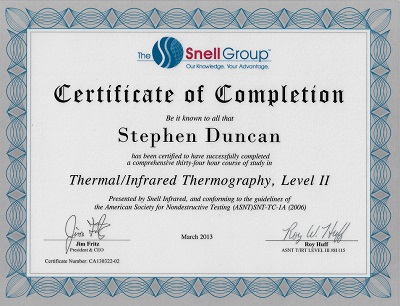What is a Thermal Imaging?
All items around us emit and produce both visible and non visible images. Infrared (IR) thermography utilizes camera like images to capture the non-visible infrared electromagnetic wavelengths. IR imagers can detect different surface temperatures and render a visual image of the thermal pattern much like a digital photograph. Using IR Thermography, inspectors can identify under appropriate conditions, thermal patterns that may indicate air and water leakage, hot electrical connections and insultation abnormalities.
In order to effectively utilize IR technology, you must hire a trained Infrared Thermographer who is knowledgeable of the object being viewed, and the ability to properly interpret the image produced by the IR imager. The minimum requirement typically accepted for image interpretation is a the Level 2 Certified Thermographer.
Why should I have my home scanned using an Infrared Camera – Infrared thermography is the best method to detect energy waste, Insulation deficiencies, moisture and electrical issues in buildings. An infrared camera shows exactly where the problems are and helps focus the inspectors’ attention allowing him or her to properly diagnose areas with energy loss or other possible issues.
Air leakage, vapour barrier, air barrier, and insulation problems can all lead to serious indoor air quality problems.
FAQ’s
Can Infrared Thermal Imaging see through the walls like an X-ray? Absolutely NOT! An infrared camera simply sees the surface heat of whatever it is looking at, in a completely passive manner. A properly trained operator can interpret the images to determine some of what is happening behind a surface. As with any technology, there are limitations, making proper training and quality equipment essential.
Before any conclusions can be drawn from thermographic images, actual conditions have to be physically verified.
Moisture Intrusion, Leaks, Condensation
Because of the thermal properties of water and the phenomenon of evaporation, active wet spots will
generally show up as “cold” spots in an infrared picture. While there is other equipment that detects active moisture, it is spot specific. Meaning it works for a very small specific location. Infrared Thermal Imaging, with the proper equipment, allows the operator to quickly and efficiently scan larger areas for suspicious active moisture spots. When a suspicious area is found, the area can be checked with a moisture meter to confirm or deny the presence of active moisture. Often with our sensitive camera we can even determine where the moisture came from.
Electrical Problems
Hot spots are often found with electrical problems. Electrical outlets, switches, wires or circuit breakers that are malfunctioning, overloaded, or compromised in some manner. These are very dangerous as they can easily lead to a catastrophic fire. Our Infrared Thermal Imaging process allows us to easily and efficiently scan for these electrical hot spots which may not have been visible to the naked eye and would have escaped notice. If the scan gives indications of problems follow-up investigation is called for to verify the problem and resolve it.
Insulation Anomalies
Insulation anomalies are also alarmingly common in construction, both new and old, in our area. With energy costs soaring, these deficiencies can lead to huge energy costs. Again, our Infrared Thermal Imaging process allows us to efficiently scan the home and identify areas that are improperly or incompletely insulated. Because this scan is completed from inside, we can see areas that may otherwise be inaccessible and therefore not visible to traditional visual inspection procedure.
Improperly Connected HVAC Ductwork
If your HVAC flex duct has not been properly sealed you could have significant leakage at joints in the attic. Infrared Thermal Imaging can identify this problem, if the connection is visible. We have found both poor connections at plenums and registers in our infrared scans. These situations are simply costing the homeowners money and comfort. Left unfixed, with the right atmospheric conditions, these can even lead to moisture problems from condensation.
Why do you charge more for a thermal imaging Inspection?
Quality, high performance infrared imaging equipment is VERY expensive. Performing a complete thermal imaging scan of the entire home also adds extra time to the Traditional Home Inspection. There are environmental conditions (both interior and exterior) that must be met to detect many defects that may be present. Often an additional visit must be scheduled to provide a thorough and meaningful Thermal
Inspection and don’t forget “Before any conclusions can be drawn from thermographic images, actual conditions have to be physically verified.”
Examples

Electrical Panel
This example is excellent. It shows a hot circuit breaker. This definitely would not have been seen without using a thermal imager.
The cause of this hot circuit could be from a wire that is not capable of handling the load on this circuit and could be considered a fire hazard.

Ceiling – Wet drywall
This is another great example of why using the thermal imager is critical to uncovering hidden potential problems. This wet spot below a roof vent really popped through the view of the thermal camera!

Ceiling – Missing Insulation
In this example, we see that an entire section of the ceiling is missing insulation. Is this a deal killer? Not at all This can be corrected… If you know about it! You definitely would not see the missing insulation in the ceiling around this light fixture. Any missing insulation is a prime money waster – and the thermal imager tells all.

Master Bedroom, Bathroom, and Closet Completely Missing Ceiling Insulation
The home owner wondered why the master bedroom was so uncomfortable year-round. This builder “oversight” cost the homeowner a significant amount of money as well as making them uncomfortable in their own bedroom. The builder had been out several times and stated that nothing was wrong.

